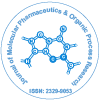Unsere Gruppe organisiert über 3000 globale Konferenzreihen Jährliche Veranstaltungen in den USA, Europa und anderen Ländern. Asien mit Unterstützung von 1000 weiteren wissenschaftlichen Gesellschaften und veröffentlicht über 700 Open Access Zeitschriften, die über 50.000 bedeutende Persönlichkeiten und renommierte Wissenschaftler als Redaktionsmitglieder enthalten.
Open-Access-Zeitschriften gewinnen mehr Leser und Zitierungen
700 Zeitschriften und 15.000.000 Leser Jede Zeitschrift erhält mehr als 25.000 Leser
Indiziert in
- CAS-Quellenindex (CASSI)
- Index Copernicus
- Google Scholar
- Sherpa Romeo
- Öffnen Sie das J-Tor
- Akademische Schlüssel
- RefSeek
- Hamdard-Universität
- EBSCO AZ
- OCLC – WorldCat
- Publons
- Euro-Pub
- ICMJE
Nützliche Links
Open-Access-Zeitschriften
Teile diese Seite
Abstrakt
A Schematic Approach for Drug Discovery While Using Plant Sources
Walter Jager
The combination of declining numbers of new drug approvals and rising prohibitive costs poses serious challenges to drug discovery. The advent of combinatorial chemistry has given rise to renewed hope of increasing the success rate of new chemical entities (NCEs). But even this scientific development has not improved the success rate of new drug discovery. This scenario has allowed us to develop a new approach to integrated drug discovery where Ayurvedic wisdom can interact with drug discovery from botanical sources. The first step in drug discovery involves NCE identification. NCEs can be obtained by chemical synthesis or isolated from natural products by biologically active fractionation. The source of many new drugs and active ingredients in pharmaceuticals comes from natural products. A starting point for discovering new plant-based medicines is to use Ayurvedic wisdom, traditional documented uses, undocumented tribal uses, and extensive literature review to identify suitable candidates. A frequency analysis of the components of anciently documented formulations and an analysis of their Ayurvedic properties will allow the selection of suitable candidate plants for fractionation based on their biological activity. We can give you a complete idea about the dominance of Vedic properties. Integrating the wisdom of Ayurveda into pharmaceutical research requires a paradigm shift in the extraction process from sequential to parallel extraction. Bioassay-based fractionation of identified plants yields standardized extracts or isolated bioactive pharmaceutical compounds as new drugs. This integrated approach improves drug discovery success rates and saves cost and time.
Zeitschriften nach Themen
- Allgemeine Wissenschaft
- Biochemie
- Chemie
- Genetik und Molekularbiologie
- Geologie und Geowissenschaften
- Immunologie und Mikrobiologie
- Klinische Wissenschaften
- Krankenpflege und Gesundheitsfürsorge
- Landwirtschaft und Aquakultur
- Lebensmittel & Ernährung
- Maschinenbau
- Materialwissenschaften
- Medizinische Wissenschaften
- Pharmazeutische Wissenschaften
- Physik
- Sozial- und Politikwissenschaften
- Umweltwissenschaften
- Veterinärwissenschaften
Klinische und medizinische Fachzeitschriften
- Anästhesiologie
- Augenheilkunde
- Betrieb
- Dermatologie
- Diabetes und Endokrinologie
- Gastroenterologie
- Genetik
- Gesundheitspflege
- Immunologie
- Infektionskrankheiten
- Kardiologie
- Klinische Forschung
- Medizin
- Mikrobiologie
- Molekularbiologie
- Neurologie
- Onkologie
- Pädiatrie
- Pathologie
- Pflege
- Toxikologie
- Zahnheilkunde

 English
English  Spanish
Spanish  Chinese
Chinese  Russian
Russian  French
French  Japanese
Japanese  Portuguese
Portuguese  Hindi
Hindi